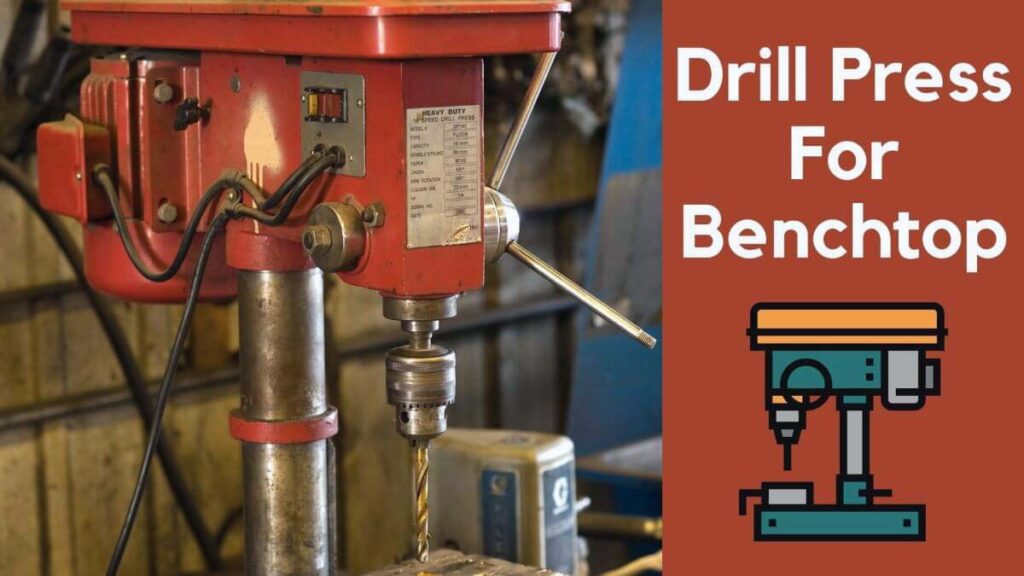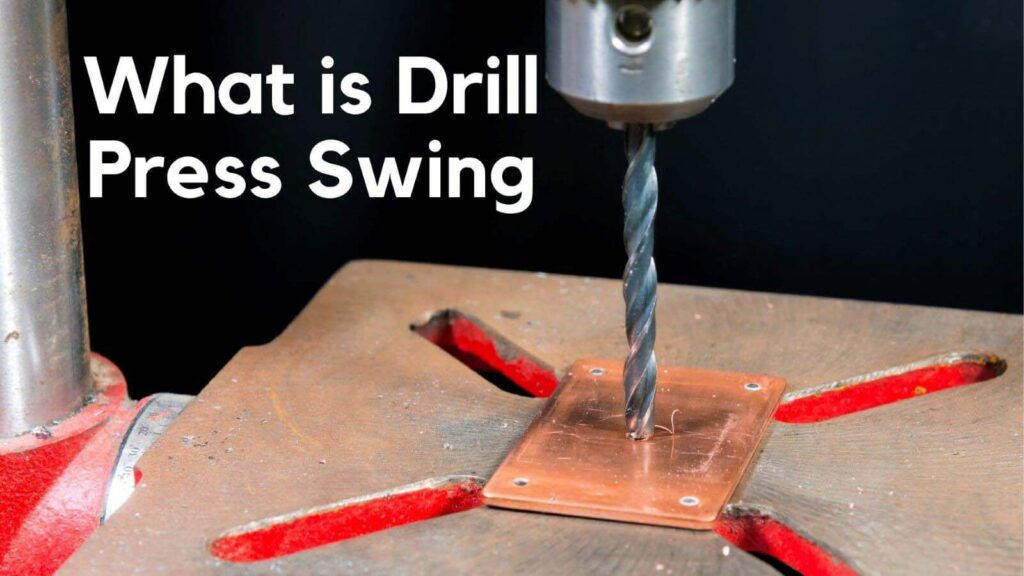The word “drill press swing” is one that you will hear a lot. Purchasing a drill press might be frightening, especially if you have never owned one before and are looking to get one.
To further add to the confusion, drill press reviews and even manufacturers frequently cite this word as one of their primary selling advantages – even including it in their specifications sheet without further explanation of what it means in practice.
For example, a drill press with a 12″ diameter. The swing is denoted by the 12-inch measurement. But, in reality, what is it?
In this article, we’ll talk about what a drill press “swing” is and how it’s important when it comes to drilling presses in general.
Table of Contents
The Definition of a Drill Press Swing
Drill press swing is the distance multiplied by two between the spindle’s centre (where the drill bit would be placed) and the support column (the pole that supports the drill press upright). Therefore, a drill press with a swing of 12″ can drill a hole in the CENTER (6″) of a 12″ circle (or square) of material.
How a Drill Press Runs?
A full-size stationary drill press is large, expensive, and takes up important work area space. However, what the drill press lacks in portability it more than compensates for with power and precision.
When you use a drill press instead of a handheld drill, you don’t have to use your arm strength or keep your balance to make a good hole.
This significantly simplifies the process of creating perfectly exact holes. Each model includes a depth stop for consistently deep holes.
Read More: How to Sharpen a Drill Bit with a File
Drill Press Swing Type
Drill presses are classified into two types: Benchtop and Floor Mount
Benchtop variants are more compact, lighter, and portable. While floor models are heavier and more difficult to manoeuvre, they offer increased power, capacity, and features.
1.Drill Press for Benchtop

Benchtop drill presses, which are smaller and more compact, are an ideal alternative for frequent but restricted use in small workshops.
They feature a tiny footprint and smaller swings, yet nevertheless, provide great drilling capabilities. Benchtop machines, which are frequently available in the 13–12 HP range with 5–16 variable speeds, are well-suited for light-duty tasks and are more inexpensive than floor mount variants.
Benchtop models, on the other hand, should not be used for heavy-duty, repetitive drilling, particularly in thicker materials.
2.Drill Press for Floor Mounted

Floor mount drill presses with a swing range of 12″ to 20″ can handle bigger materials. They are suited for heavy-duty repeated operations and can easily drill deeper holes through thicker, more difficult-to-drill material. Floor mount drill presses are significantly more expensive than benchtop drill presses due to their greater sizes and increased capabilities.
Drill Press Swing Size
Swing and spindle travel are the two primary dimensions to consider when sizing a drill press.
Swing is the distance multiplied by two between the machine’s centre column and spindle. This specifies the maximum width of material that can be bored to the centre of a workpiece on your drill press.
Spindle travel refers to the depth to which your drill press may descend as you rotate the handle. Benchtop variants may only allow for two or three vertical inches of downward movement, but the best full-sized units, such as this highly-rated Delta model, allow for five or six inches of downward movement.
Read More: How to Measure Drill Press Size
Drill Press Swing Power
Calculating watts is the most accurate approach to determine the power of a drill press. On the electrical nameplate of each model, amp and volt statistics are displayed. Watts are calculated by multiplying these values together. The greater the wattage, the more powerful the tool and the tougher the materials it can bore.
The largest floor-model drill presses for home workshops have a power output of approximately 1,000 watts. Benchtop models typically have a power output of around a third to a half of this.
Read More: How To Drill Aluminum
Drill Press Swing Speed
The majority of drill presses feature variable rotation rates to facilitate drilling in a variety of materials. Speeds are increased on higher-end models. Bench-top machines normally feature five or six speeds, but a high-quality floor model may feature up to sixteen. Why is rotational speed critical? The more difficult the material being drilled, the slower the drill bit speed required.
Read More : How to Remove a Stuck Drill Bit from Wood?
Explanation of Drill Press Swing And Drilling Capacity
Drill Press Swing is the distance the drill machine travels in a single rotation. This is different from power, which is the amount of energy it produces.
Drill Press Capacity is the maximum depth you are able to drill into an object before breakage occurs or before you have to change out your drill bit for a larger one.
The capacity of a drill press can be increased by changing components, like the drive pulley or work table. Drill presses that use larger diameter bits will be able to drill deeper than smaller ones due to less friction and more torque but will use more power and produce less force for cutting.
We will now talk about the maximum drilling capacity for a 12″ piece of plywood. We will use the same 12″ swing for this example (that we talked about before) (easy example to show).
If we have a square (or circular) piece of plywood on which we wish to drill a hole in the middle, a drill press with a 12″ swing will suffice, but the maximum swing will be reached.
Why is it Essential?
The swing size essentially indicates the maximum size of material that the drill press can handle. For instance, a drill press with a 12″ swing (12″ Drill Press) will accommodate a maximum of 6″ on the table.
It cannot exceed this limit otherwise it will crash with the bench column. Thus, you cannot use a 12″ drill press to drill a hole 7″ from the edge of your material. That will require a 14″ drill press.
How Many Swing Sizes Do You Require?
It will vary according to the size of material you typically work with. If you’re working with very little pieces of material, a mini drill press with a 5″ swing will do. Small materials with a maximum width of 2.5″ will fit nicely in a 5″ drill press and allow for unfettered drilling on the drill press table.
However, we recommend that you choose one that is as large as feasible for general purpose drilling in the workshop. The swing size of the majority of commercial drill presses is between 10″ and 14″.
A drill press with a swing of 10″-12″ will usually do the trick for most folks and can be obtained for under $200.
Read More: How to Drill a Hole in Plastic Without a Drill?
Why is a Large Drill Press Swing Better?
The large swing area of the press makes it possible to drill deep holes. The large swing area also minimizes the need for drilling through workpieces twice, which can cause problems with alignment
The larger swing area also allows the drill press to be used more efficiently by enabling longer and heavier drills to be used on workpieces without compromising stability.
Large drill presses have a swing that is greater than 600 mm. They have a high working radius, which allows for one to drill into large pieces of metal.
Large drill presses provide a higher degree of precision and power. They are more affordable and require less space than the smaller ones.
A drill press with a broad swing offers more drilling freedom. You can always move the material on the drill table, but not the drill bit, as the quill only travels up and down.
Keep in mind that larger swing size drill presses are often more expensive. Fortunately, a more expensive and larger swing size drill press also means a more powerful drill press with more features.
FAQ’s
Is drill press swing the same as throat depth?
No, throat depth refers to the distance from the column to the center of the chuck, while swing refers to the maximum width of material that can be accommodated on the table.
Can I work on smaller projects with a large swing drill press?
Yes, a drill press with a large swing can accommodate smaller projects. However, a smaller swing drill press might be more efficient for intricate tasks.
Can I modify the swing measurement of a drill press?
The swing measurement is a fundamental design feature of a drill press and cannot be easily modified.
Is swing the only factor to consider when buying a drill press?
No, other factors like horsepower, drilling depth, and speed options are also crucial when choosing a drill press.
Is it advisable to always opt for the largest swing available?
While a larger swing provides versatility, consider your workspace and typical project sizes. A swing that meets your needs without being excessive is ideal.
Final Thought
The drill press swing is a confusing term. Now that you know what it is, you can better choose a drill press depending on your needs and the normal material size you operate with. When buying a drill press, consider the swing size. It will save your time. Remember, the bigger the swing, the better.

Hey, I am Shihab Uddin, I’m a huge fan of DIY crafts. My workshop is where I spend most of my spare time, and I’m always working on some project. To that end, I’d like to share some of my knowledge and experience with you in power tools, woodworking, and other specialized materials fabrication.
I will guide you with genuine knowledge that can assist you with deciding whether a drill is appropriate according to your requirements or not. If you want to find the best drill and know which type of drill is most suited for your needs, then I can guide you with my expertise. My passion lies in helping others find the correct products they need at an affordable price.


